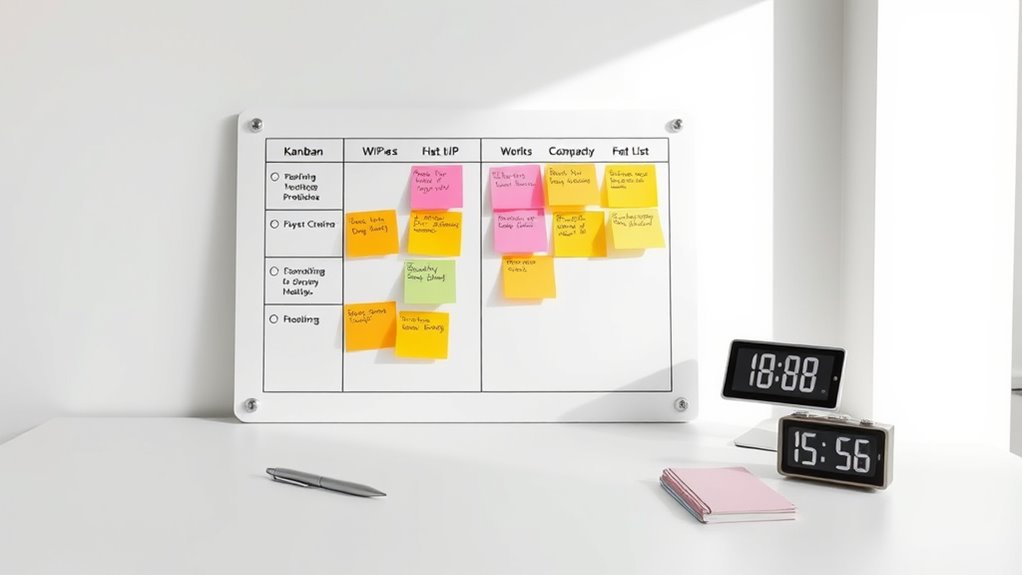Implementing WIP limits helps you finish more tasks faster by reducing multitasking and chaos. When you limit work in progress, you focus on completing current tasks before starting new ones, which improves prioritization and efficiency. This approach prevents overwhelm and encourages discipline, leading to better quality work and higher motivation. If you want to discover how setting WIP limits can transform your workflow, there’s more to explore below.
Key Takeaways
- WIP limits encourage focusing on completing current tasks before starting new ones, boosting overall productivity.
- Limiting work in progress reduces multitasking and chaos, leading to faster task completion.
- Clear workload boundaries enhance team collaboration and prevent bottlenecks.
- Prioritizing fewer tasks ensures critical work is finished efficiently, improving quality.
- Implementing WIP limits creates a sustainable workflow, minimizing stress and increasing motivation.

Have you ever felt overwhelmed by a growing to-do list or noticed your team struggling to complete tasks efficiently? It’s a common challenge in many workplaces. One effective way to tackle this is by implementing WIP limits—work-in-progress limits—that help manage your workflow better. When you set clear boundaries on how many tasks can be in progress at once, you force yourself and your team to focus on finishing work before starting new tasks. This approach encourages better task prioritization, allowing everyone to concentrate on high-impact activities rather than juggling multiple half-done projects. By limiting WIP, you make it easier to identify what truly matters, ensuring your team isn’t overwhelmed by too many simultaneous demands.
Setting WIP limits helps your team focus, prioritize, and complete tasks efficiently without feeling overwhelmed.
Task prioritization becomes more straightforward with WIP limits because you’re forced to evaluate the importance and urgency of each task. Instead of constantly shifting between different activities, you’ll focus on completing the most critical ones first. This clarity helps eliminate the chaos that often comes with multitasking and prevents tasks from lingering unfinished because your team is stretched too thin. When everyone knows that only a certain number of tasks can be worked on at once, it naturally promotes discipline and strategic decision-making. You’ll find that your team collaborates more effectively because they’re no longer distracted by an endless stream of work. Instead, they work together to push through the prioritized tasks and finish them efficiently.
Implementing WIP limits also fosters better team collaboration. When the workload is clearly defined, team members can coordinate more seamlessly, knowing exactly what needs attention and what can wait. It reduces confusion, prevents duplicated effort, and minimizes bottlenecks. With everyone aligned on the current priorities, communication improves, and team members support each other to move tasks across the finish line. This shared understanding creates a more cohesive environment where progress is visible, and everyone feels responsible for completing their part. As a result, your team not only completes more work but does so with less stress, making the overall process more sustainable. Additionally, understanding crochet styles for locs can serve as an example of how focusing on specific techniques helps streamline creative workflows in crafts and beyond.
Ultimately, WIP limits are about working smarter, not harder. They help you and your team focus on finishing tasks rather than just starting new ones. By honing task prioritization and enhancing team collaboration, you create a workflow that’s more efficient, less chaotic, and more satisfying for everyone involved. It’s a simple change with powerful results—fewer unfinished projects, higher quality work, and a more motivated team. When you implement WIP limits, you’ll notice the difference almost immediately, making it easier to finish more by doing less.
Frequently Asked Questions
How Do WIP Limits Impact Team Morale?
WIP limits boost your team motivation by reducing overwhelm and creating a clearer focus on tasks. When you set these limits, your team experiences less stress, knowing they’re not overburdened. This environment encourages collaboration and a sense of accomplishment, which further lifts morale. As a result, your team feels more engaged, productive, and satisfied, leading to better overall performance and a positive work atmosphere.
Are WIP Limits Suitable for All Project Types?
WIP limits aren’t suitable for all project types, especially those with unpredictable workflows or high variability. They help you identify workflow bottlenecks and improve resource allocation, but in projects requiring rapid, flexible responses, strict limits can hinder progress. Assess your project’s complexity and stability first; if it’s stable and predictable, WIP limits can streamline your process. Otherwise, consider more adaptable approaches.
How to Set Appropriate WIP Limits for New Teams?
To set appropriate WIP limits for new teams, start by evaluating their task prioritization and workflow capacity. Engage team members to determine a manageable workload, encouraging team autonomy in adjusting limits as they gain experience. Begin with conservative limits, monitor progress, and refine them based on throughput and bottlenecks. This approach helps balance productivity and quality, fostering ownership and continuous improvement.
Can WIP Limits Be Adjusted During a Project?
Yes, you can adjust WIP limits during a project. Keep an eye on your Kanban board and WIP policies to see if the current limits are slowing down progress or causing bottlenecks. By regularly reviewing these, you can fine-tune WIP limits to improve flow and efficiency. Just guarantee your team agrees on the changes, so everyone stays aligned and maintains a smooth workflow.
What Tools Assist in Managing WIP Limits Effectively?
You can effectively manage WIP limits with the right tools. Visual management boards make it easy to see workload at a glance, while digital dashboards provide real-time updates and insights. These tools help you spot bottlenecks early, adjust WIP limits dynamically, and keep your team aligned. The secret to smooth workflow? Consistently leveraging these tools to stay proactive, making adjustments before issues escalate.
Conclusion
By limiting your Work In Progress, you boost focus and efficiency. Studies show teams with WIP limits complete tasks 30% faster and with fewer errors. When you cut down on multitasking and unnecessary work, you’ll find yourself finishing more projects in less time. Remember, doing less at a given moment helps you finish more overall. Embrace WIP limits today, and watch your productivity soar as you work smarter, not harder.










